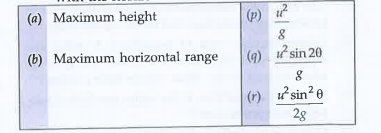A particle is projected with a velocity u making an angle θ with the horizontal. At any instant its velocity becomes v which is perpendicular to the initial velocity u. Then v is
ucosθ
utanθ
usecθ
ucotθ
The correct Answer is:D
To solve the problem, we need to analyze the motion of a particle projected at an angle with an initial velocity and determine the conditions when its velocity becomes perpendicular to the initial velocity.
1. Understanding the Initial Velocity:
The particle is projected with an initial velocity u at an angle θ with the horizontal. We can resolve this initial velocity into its horizontal and vertical components:
- Horizontal component: ux=ucos(θ)
- Vertical component: uy=usin(θ)
2. Velocity at Any Instant:
As the particle moves under the influence of gravity, its vertical component of velocity changes due to gravitational acceleration. The vertical component of velocity vy at any time t can be expressed as:
vy=uy−gt=usin(θ)−gt
The horizontal component of velocity remains constant:
vx=ux=ucos(θ)
3. Condition for Perpendicularity:
The velocity v becomes perpendicular to the initial velocity u when the dot product of the two velocity vectors is zero. This can be expressed mathematically as:
ux⋅vx+uy⋅vy=0
Substituting the components:
(ucos(θ))(ucos(θ))+(usin(θ))(usin(θ)−gt)=0
4. Simplifying the Equation:
Expanding the equation gives:
u2cos2(θ)+usin(θ)(usin(θ)−gt)=0
This simplifies to:
u2cos2(θ)+u2sin2(θ)−ugtsin(θ)=0
Using the identity cos2(θ)+sin2(θ)=1:
u2−ugtsin(θ)=0
5. Finding Time t:
Rearranging gives:
ugtsin(θ)=u2
Thus,
t=ugsin(θ)
6. Calculating the Velocity v:
Now we can find the magnitude of the velocity v when it is perpendicular to u. The magnitude of the velocity v can be calculated using:
v=√v2x+v2y
Substituting the components:
vx=ucos(θ)andvy=usin(θ)−gt
Substituting t:
vy=usin(θ)−g(ugsin(θ))=usin(θ)−u1sin(θ)=u(sin(θ)−1sin(θ))
7. Final Expression for v:
Therefore, the magnitude of the velocity v when it is perpendicular to the initial velocity u is:
v=
⎷(ucos(θ))2+(u(sin(θ)−1sin(θ)))2
The particle is projected with an initial velocity u at an angle θ with the horizontal. We can resolve this initial velocity into its horizontal and vertical components:
- Horizontal component: ux=ucos(θ)
- Vertical component: uy=usin(θ)
As the particle moves under the influence of gravity, its vertical component of velocity changes due to gravitational acceleration. The vertical component of velocity vy at any time t can be expressed as:
vy=uy−gt=usin(θ)−gt
The horizontal component of velocity remains constant:
vx=ux=ucos(θ)
The velocity v becomes perpendicular to the initial velocity u when the dot product of the two velocity vectors is zero. This can be expressed mathematically as:
ux⋅vx+uy⋅vy=0
Substituting the components:
(ucos(θ))(ucos(θ))+(usin(θ))(usin(θ)−gt)=0
Expanding the equation gives:
u2cos2(θ)+usin(θ)(usin(θ)−gt)=0
This simplifies to:
u2cos2(θ)+u2sin2(θ)−ugtsin(θ)=0
Using the identity cos2(θ)+sin2(θ)=1:
u2−ugtsin(θ)=0
Rearranging gives:
ugtsin(θ)=u2
Thus,
t=ugsin(θ)
Now we can find the magnitude of the velocity v when it is perpendicular to u. The magnitude of the velocity v can be calculated using:
v=√v2x+v2y
Substituting the components:
vx=ucos(θ)andvy=usin(θ)−gt
Substituting t:
vy=usin(θ)−g(ugsin(θ))=usin(θ)−u1sin(θ)=u(sin(θ)−1sin(θ))
Therefore, the magnitude of the velocity v when it is perpendicular to the initial velocity u is:
v=
⎷(ucos(θ))2+(u(sin(θ)−1sin(θ)))2
Topper's Solved these Questions
- BOOK - A2ZCHAPTER - MOTION IN TWO DIMENSIONEXERCISE - Projectile From A Height And Movingframe19videos
MOTION IN TWO DIMENSION
- BOOK - A2ZCHAPTER - MOTION IN TWO DIMENSIONEXERCISE - Projection From Inclined Plane20videos
MOTION IN TWO DIMENSION
- BOOK - A2ZCHAPTER - MOCK TESTEXERCISE - Motion With Constant Acceleration15videos
MOCK TEST
- BOOK - A2ZCHAPTER - NEWTONS LAWS OF MOTIONEXERCISE - Chapter Test30videos
NEWTONS LAWS OF MOTION
Similar Questions
Knowledge Check
- Question 1 - Select One
A particle is projected with a velocity u making an angle θ with the horizontal. The instantaneous power of the gravitational force
A(a) Varies linearly with timeB(b) Is constant throughoutC(c) Is negative for complete pathD(d) None of the above - Question 2 - Select One
A particle is projeced with a velocity u making an angle θ with the horizontal. The instantaneous power of the gravitational force
Avaries linearly with timeBis constant throughout the pathCis negative for complete pathDvaries inversly with time - Question 3 - Select One
A particle is projected with initial velocity u making an angle α with the horizontal, its time of flight will be given by
A2usinαgB2u2sinαgCusinαgDu2sinαg
A projectile is fired with a velocity 'u' making an angle θ with the horizontal. Show that its trajectory is a parabola.
View Solution" A body is projected with velocity u making an angle 300 with the horizontal.Its velocity when it is perpendicular to the initial velocity vector is "
View SolutionA projectile is projected with velocity u making angle θ with horizontal direction, find : horizontal range.
View SolutionA particle is projected with velocity u at angle θ with horizontal. Find the time when velocity vector is perpendicular to initial velocity vector.
View SolutionA particle is fired with velocity u making angle θ with the horizontal.What is the change in velocity when it is at the highest point?
View Solution


